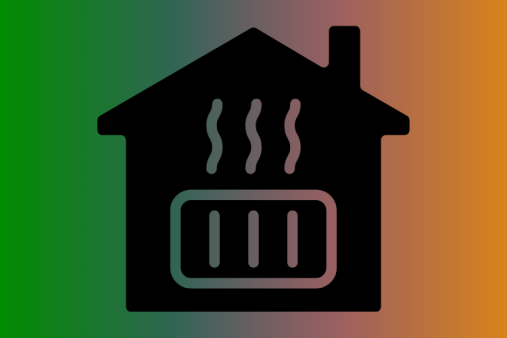In the intricate world of heating, understanding the lingo is vital for homeowners, DIY enthusiasts, and professionals alike. Whether you're deciphering a boiler manual, discussing system upgrades with a technician, or simply trying to make informed decisions about your home's heating, having a clear grasp of the terminology can make all the difference.
That's why we've created this comprehensive A-Z heating glossary. Covering over 100 essential terms, this glossary will demystify the jargon, from 'AFUE' to 'Zone Control', and everything in between. Whether you're tackling a DIY project or engaging with a tradesperson, our glossary is designed to empower you with the knowledge you need to navigate the heating world with confidence. Dive in, and let’s turn those complex terms into straightforward concepts!
A
- Accreditation
Accreditation in home improvement services in the UK is a process through which companies can demonstrate their commitment to quality, safety, and professionalism. It involves an independent evaluation of a company's policies, procedures, and practices against established criteria and standards specific to the home improvement industry.
In the UK, there are several organizations that provide accreditation services to home improvement companies, including the Federation of Master Builders (FMB) and TrustMark. These organizations assess companies' compliance with industry-specific regulations and standards, such as building regulations, health and safety requirements, and codes of conduct.
The process of accreditation in home improvement services in the UK can involve a rigorous assessment of a company's practices and standards. For example, the FMB requires companies to meet certain eligibility criteria before they can apply for accreditation. These criteria include having at least 12 months' experience in the construction industry, being financially stable, and having adequate insurance.
Once a company is eligible, the accreditation process typically involves an assessment of the company's workmanship, customer service, and business practices. This assessment can include site visits, customer references, and a review of the company's policies and procedures.
The benefits of accreditation in home improvement services in the UK are significant for both companies and customers. For companies, accreditation can help to enhance their reputation, increase customer confidence, and provide a competitive advantage. For customers, accreditation can provide assurance that a company is reputable, competent, and adheres to industry standards.
In addition to the benefits for companies and customers, accreditation in home improvement services in the UK can also help to improve industry standards overall. By promoting best practices and adherence to regulations, accreditation can help to raise the quality of work and reduce the risk of poor workmanship and disputes.
In conclusion, accreditation in home improvement services in the UK is a valuable process for companies and customers alike. It involves an independent assessment of a company's policies, procedures, and practices against industry-specific standards, and can provide numerous benefits, including enhanced reputation, increased customer confidence, and improved industry standards.
- AFUE (Annual Fuel Utilization Efficiency): A measure of furnace efficiency, representing the percentage of fuel converted to heat.
-
Air Gap
In heating, an air gap refers to a space between two surfaces that prevents the transfer of heat through conduction. This is often achieved by leaving a small gap between the heating element (such as a radiator or heating coil) and the surface it is heating (such as a wall or floor).
By creating an air gap, heat is prevented from being conducted directly from the heating element to the surface, and instead, the air in the gap acts as an insulator, reducing the amount of heat that is lost. This can improve the efficiency of the heating system and reduce energy costs.
Air gaps can also be used in insulation to prevent heat transfer by conduction. For example, double-pane windows often have an air gap between the two panes of glass to improve insulation and reduce heat loss. In heating systems, air gaps may also be used to prevent the buildup of moisture or condensation on surfaces, which can lead to corrosion or other damage.
- Air Handler: A device that moves air through ductwork and into rooms.
- Ambient Temperature: The temperature of the air surrounding a heating appliance.
- Annual Service
In the context of home improvement services, an annual service typically refers to a routine maintenance check that is carried out on a home's mechanical or electrical systems, appliances, or equipment. This service is usually performed on an annual basis to ensure that these systems are functioning correctly and efficiently, and to identify and address any issues before they become major problems.
For example, in the heating and cooling industry, an annual service might involve inspecting and cleaning the furnace or air conditioning unit, replacing filters, checking for leaks, and ensuring that all components are functioning properly. Similarly, in the plumbing industry, an annual service might involve checking for leaks, inspecting the water heater, and ensuring that all pipes and fixtures are in good condition.
An annual service can be beneficial for homeowners in several ways. By ensuring that home systems and equipment are functioning efficiently, homeowners can save money on energy bills and avoid costly repairs in the long run. Additionally, regular maintenance can help to extend the lifespan of home systems and equipment, reducing the need for replacements and saving money in the long run.
In some cases, an annual service may be required to maintain the warranty on home systems or equipment. For example, many heating and cooling systems require annual maintenance in order to keep the warranty valid. Homeowners should always check the warranty requirements for their specific systems or equipment to ensure that they are meeting the necessary maintenance requirements.
In conclusion, an annual service in home improvement services typically refers to routine maintenance checks that are carried out on a home's mechanical or electrical systems, appliances, or equipment. This service can provide numerous benefits for homeowners, including improved efficiency, reduced energy bills, and extended equipment lifespan, and may be required to maintain warranties on certain systems or equipment.
- Antifreeze: A liquid added to heating systems to prevent freezing.
- Asbestos: A heat-resistant fibrous mineral previously used in heating systems, now banned due to health risks.
B
- Balanced Flue: A type of flue that allows air to enter and gases to exit, ensuring efficient combustion and safe operation.
- Bar (Unit of Measurement)
In the UK, the bar is a unit of pressure measurement that is commonly used in the engineering and construction industries. One bar is equivalent to 100,000 Pascals (Pa), which is the SI unit of pressure.
The bar is often used as a measure of atmospheric pressure, with standard atmospheric pressure at sea level being approximately 1 bar. This means that air pressure decreases with increasing altitude, resulting in lower atmospheric pressure at higher elevations.
In addition to its use in measuring atmospheric pressure, the bar is also used to measure pressure in fluid systems, such as pipelines, hydraulic systems, and gas systems. In these applications, pressure is typically measured in bars or kilobars (kbar), with one kbar being equal to 1,000 bars.
The bar is a convenient unit of measurement for pressure because it is relatively easy to understand and work with, and is commonly used in industry and scientific research. However, it is important to note that other units of pressure measurement, such as pounds per square inch (psi) and Pascal, are also used in the UK and in other parts of the world, depending on the context and industry.
- Baxi
Baxi is a brand that produces heating systems and boilers for residential and commercial use. The company was founded in the UK in 1866 and has since become one of the leading manufacturers of heating equipment in Europe.
Baxi offers a range of products including combi boilers, system boilers, and heat-only boilers, as well as accessories and controls for heating systems. The company is known for its focus on energy efficiency, with many of its products featuring high-efficiency ratings and eco-friendly features.
In addition to its heating products, Baxi also offers installation and maintenance services for its equipment, as well as training and support for heating professionals. The company has a strong reputation for quality and reliability in the heating industry, and is a popular choice for homeowners and businesses alike.
- Biomass Boiler: A heating system that uses organic materials, such as wood pellets, to generate heat.
- Bleeding: The process of removing air from radiators to improve efficiency.
- Boiler: A device that heats water for central heating and domestic hot water.
- Boilerplate: The metal plate that forms the structure of a boiler.
C
- Central Heating: A system that heats multiple rooms from a single source.
- Centralised boiler scheme
In the UK, a centralised boiler scheme is a system that provides heating and hot water to multiple homes or buildings from a central boiler or plant. This type of system is typically used in larger residential or commercial developments, such as apartment blocks or office buildings, where it is not practical or cost-effective to install individual heating systems for each unit.
In a centralised boiler scheme, a large boiler or plant is located in a central location, such as a plant room, and is connected to a network of pipes that distribute hot water or steam to each unit. Each unit is equipped with a heat exchanger, which extracts the heat from the hot water or steam and uses it to provide heating and hot water for the individual unit.
Centralised boiler schemes offer several benefits over individual heating systems, including:
-
Lower installation costs: Installing a single, centralised system is often less expensive than installing individual heating systems in each unit.
-
Reduced maintenance costs: With a centralised system, maintenance and repairs can be carried out more efficiently and cost-effectively than with individual systems.
-
Improved energy efficiency: Centralised systems are often more energy efficient than individual systems, as they can be optimised to operate at peak efficiency.
-
Greater control: Centralised systems can be managed and controlled centrally, allowing for greater control over energy usage and costs.
However, centralised boiler schemes can also have some drawbacks, such as the potential for heat loss through the network of pipes and the need for a backup system in case of boiler failure.
Overall, the use of centralised boiler schemes in the UK is becoming more common as developers and building owners look for cost-effective and energy-efficient ways to provide heating and hot water to multiple units or buildings.
- CHP (Combined Heat and Power): A system that generates both heat and electricity from a single energy source.
- Circulator Pump: A pump used to circulate water in a heating system.
- Combi Boiler: A boiler that provides both heating and hot water directly from the mains.
- Commissioning
In home improvement services, commissioning refers to the process of ensuring that a newly installed or upgraded system or equipment is functioning properly and efficiently. The commissioning process involves a series of tests and inspections to ensure that the system or equipment is installed correctly, operates as intended, and meets the required standards and specifications.
Commissioning is typically carried out by a qualified professional, such as a building services engineer or a commissioning specialist. The commissioning process may include:
-
Pre-commissioning checks: This involves inspecting the system or equipment to ensure that it has been installed correctly and that all components are present and functioning.
-
Functional testing: This involves carrying out tests to ensure that the system or equipment is operating as intended and meets the required performance standards.
-
System integration: This involves testing how the newly installed or upgraded system or equipment works in conjunction with other systems and equipment in the building.
-
Performance testing: This involves measuring and verifying the performance of the system or equipment, such as energy efficiency and environmental conditions.
-
Documentation and handover: This involves creating a commissioning report that documents the tests and inspections carried out and provides recommendations for any necessary corrective actions. The report is then handed over to the building owner or operator.
Commissioning is an important part of the installation and maintenance process in home improvement services, as it ensures that the systems and equipment are installed correctly and are operating at peak efficiency. This can result in lower operating costs, improved energy efficiency, and better indoor air quality, among other benefits.
- Condensing Boiler: A highly efficient boiler that condenses water vapour in exhaust gases to recover heat.
- Convector Heater: A heater that warms the air by convection.
- Corgi: Formerly the UK gas safety regulatory body, now replaced by Gas Safe Register.
- Cylinder Thermostat: A device that controls the temperature of the hot water cylinder.
- Cylinder (water heating)
In the UK, a cylinder is a common type of water heating system that is used to store hot water for use in domestic and commercial buildings. The cylinder is typically a large, insulated tank that is connected to a boiler or other heat source.
The way a cylinder system works is that cold water is fed into the cylinder from the mains water supply. The water is heated by the boiler or other heat source, and the hot water is then stored in the cylinder until it is needed.
Cylinder systems come in various sizes and capacities, depending on the needs of the building and the number of people who will be using hot water. They can also be designed to work with different types of heat sources, including gas boilers, electric heaters, and renewable energy sources such as solar panels.
One advantage of cylinder systems is that they can provide a reliable supply of hot water, even in buildings with high demand. They are also relatively energy-efficient, as they can be designed to work with modern condensing boilers that extract more heat from the fuel they burn.
However, cylinder systems do have some disadvantages, including the need for a large amount of space to accommodate the cylinder, and the fact that the hot water can run out if the cylinder is not large enough to meet the demand. Additionally, cylinder systems can take some time to heat up, which may be inconvenient for users who need hot water quickly.
Overall, cylinder systems are a popular choice for water heating in the UK, and are widely used in both residential and commercial buildings.
D
- Deaerator: A device that removes air from water in a heating system.
- Defrost Cycle: A process in heat pumps to remove ice build-up.
- Diaphragm Expansion Vessel: A component that accommodates the expansion of water in a heating system.
- Direct Heating System: A system where heat is applied directly to the space or object.
- Direct unvented cylinder
A direct unvented cylinder is a type of hot water cylinder that is connected directly to the mains water supply, without the need for a cold water tank. This means that the cylinder can be located anywhere in the property, as it does not rely on gravity to fill the tank.
The direct unvented cylinder works by heating the water directly through an immersion heater or an electric element, which is located inside the cylinder. When a hot water tap is turned on, the mains water pressure forces the hot water out of the cylinder and through the tap.
Direct unvented cylinders are typically used in properties where there is limited space for a cold water tank, or where the water pressure from the mains supply is sufficient to supply the entire property. They are also popular in properties with multiple bathrooms or showers, as they can provide a high volume of hot water quickly and efficiently.
One advantage of direct unvented cylinders is that they can provide hot water at mains pressure, which means that there is no need for additional pumps or boosters to increase water pressure. They are also highly efficient, as they do not lose heat through a feed and expansion tank, and can be fitted with additional insulation to further reduce heat loss.
However, there are some potential drawbacks to using a direct unvented cylinder. As they rely solely on the mains water pressure, if the pressure drops or there is a supply issue, the hot water supply to the property can be affected. Additionally, as the cylinder is connected directly to the mains water supply, it is important to ensure that the system is installed correctly and complies with building regulations to prevent the risk of water damage or scalding.
- Distric heating scheme
A district heating scheme, also known as a heat network, is a system that provides heating and hot water to multiple buildings from a central source. In the UK, district heating schemes are becoming increasingly popular as a way to reduce carbon emissions and increase energy efficiency.
In a district heating scheme, heat is generated at a central location, such as a large boiler or combined heat and power (CHP) plant. The heat is then transported through a network of insulated pipes to individual buildings, where it is used to provide space heating and hot water.
District heating schemes can be fueled by a variety of sources, including biomass, waste heat, and renewable energy sources such as solar and geothermal. This allows the scheme to be more sustainable and reduce carbon emissions compared to traditional heating systems, which rely on fossil fuels.
One of the main advantages of a district heating scheme is that it can be more cost-effective for individual buildings than installing their own heating systems. The central heating plant can be more efficient and provide economies of scale, which can result in lower energy bills for customers. Additionally, the central plant can be monitored and maintained more easily, reducing the risk of breakdowns or maintenance issues.
However, there are also some potential drawbacks to district heating schemes. The initial cost of installing the network can be high, and there may be disruption during the installation process. Additionally, the central heating plant may be located some distance from the buildings it serves, which can result in heat losses and reduce efficiency. It is also important to ensure that the system is designed and installed correctly, to prevent the risk of leaks or overheating.
Overall, district heating schemes are a promising solution for reducing carbon emissions and improving energy efficiency in the UK. With careful planning and implementation, they can provide reliable, cost-effective heating and hot water to communities and businesses across the country.
- ​Diverter Valve: A valve that directs water to either the radiators or the hot water tap in a combi boiler system.
- Draw Off
In the context of heating, "draw off" refers to the process of removing heated water from a heating system. This is typically done to provide hot water for domestic or commercial use, such as for showers or washing dishes.
The draw off process involves opening a valve or tap on the heating system to allow hot water to flow out. This water is then replaced with cooler water, which is heated in turn by the heating system. The draw off rate can be adjusted depending on the needs of the user and the capacity of the heating system.
Draw off is an important factor to consider in the design and installation of heating systems, particularly in larger or commercial systems. The system must be capable of providing sufficient hot water for the expected draw off rate, while also maintaining a consistent temperature throughout the system.
Efficient draw off can also help to reduce energy usage and costs, by ensuring that only the required amount of water is heated and that excess hot water is not wasted. This can be achieved through the use of timers, controls and sensors to regulate the heating system and prevent overheating or unnecessary heating.
- Dry Cycling: When a boiler turns on and off frequently without significant heat demand, wasting energy.
E
- Efficiency: The ratio of useful heat output to energy input in a heating system.
- Electric Boiler: A boiler that uses electricity to heat water.
- Emitter: A device, such as a radiator, that releases heat into a room.
- Energy Performance Certificate (EPC): A rating of the energy efficiency of a building.
- Expansion Tank: A tank that accommodates the expansion of water in a heating system.
- Exhaust Flue: A pipe that vents combustion gases to the outside.
F
- Fan Coil Unit: A device that uses a fan to move air over a coil heated by hot water.
- Feed and Expansion Tank: A tank that supplies water to the heating system and accommodates expansion.
- Ferroli: A brand of boilers and heating products.
- Frost Protection: A feature in heating systems to prevent pipes from freezing.
- Fuel Oil: A type of oil used in some heating systems.
G
- Gas Boiler: A boiler that uses natural gas or LPG as fuel.
- Gas Safe Register: The official gas registration body for the UK.
- Gravity-Fed System: A heating system that relies on gravity to circulate water.
- Ground Source Heat Pump (GSHP): A heat pump that extracts heat from the ground.
- Glycol: A type of antifreeze used in heating systems.
H
- Heat Exchanger: A device that transfers heat from one medium to another.
- Heat Loss: The transfer of heat from inside to outside a building.
- Heat Pump: A device that transfers heat from a cooler to a warmer area.
- Heating Load: The amount of heat energy required to maintain a desired temperature.
- Hot Water Cylinder: A tank that stores hot water for domestic use.
I
- Immersion Heater: An electric heater that heats water in a hot water cylinder.
- Induced Draft: A method of drawing combustion gases through a boiler.
- Inhibitor: A chemical added to heating systems to prevent corrosion and scale.
- Insulation: Material that reduces heat loss.
- Inverter: A component in heat pumps that adjusts the speed of the compressor.
J
- Joule: A unit of energy used to measure heat output.
- Jointing Compound: A material used to seal joints in heating systems.
K
- Kilowatt (kW): A unit of power used to measure heat output.
- Kilowatt-hour (kWh): A unit of energy used to measure consumption.
L
- Lagging: Insulation applied to pipes to prevent heat loss.
- Legionella: A bacteria that can grow in hot water systems, causing Legionnaires' disease.
- LPG (Liquefied Petroleum Gas): A type of gas used as fuel in heating systems.
- Low-Carbon Heating: Heating systems that produce fewer carbon emissions.
- Low-Temperature Hot Water (LTHW): Water heated to a lower temperature to increase efficiency.
M
- Magnetic Filter: A device that removes metal particles from the water in a heating system.
- Mains Pressure: The pressure of water supplied from the mains.
- Manifold: A device that distributes water to different parts of a heating system.
- Megaflow: A brand of unvented hot water cylinders.
- Modulating Burner: A burner that adjusts its output to match the heating demand.
N
- Net Zero: Achieving a balance between the amount of greenhouse gases emitted and removed from the atmosphere.
- Nozzle: A component that controls the flow of fuel in a boiler.
- NRV (Non-Return Valve): A valve that allows fluid to flow in only one direction.
O
- Open Vent System: A heating system with a feed and expansion tank open to the atmosphere.
- Oil Boiler: A boiler that uses oil as fuel.
- On-Demand Water Heater: A heater that provides hot water only when needed.
- Oxidation: The chemical reaction that can cause corrosion in heating systems.
P
- Part L: Building regulations related to the conservation of fuel and power.
- Pilot Light: A small flame used to ignite the main burner in older boilers.
- Plate Heat Exchanger: A type of heat exchanger that uses plates to transfer heat.
- Pressure Relief Valve: A safety device that releases pressure if it becomes too high.
- Programmer: A device that allows users to set heating schedules.
Q
- Quick Recovery Cylinder: A hot water cylinder that heats water rapidly.
- Quiet Operation: Heating systems designed to operate with minimal noise.
R
- Radiant Heater: A heater that emits infrared radiation to warm objects and people.
- Radiator: A device that emits heat into a room by convection and radiation.
- Room Thermostat: A device that controls the temperature of a room.
- RHI (Renewable Heat Incentive): A government scheme that provides financial incentives for using renewable heating technologies.
S
- Sealed System: A heating system that operates under pressure without a feed and expansion tank.
- Secondary Heat Exchanger: A second heat exchanger in a boiler that improves efficiency.
- Sedbuk Rating: A rating system for boiler efficiency in the UK.
- Smart Thermostat: A thermostat that can be controlled remotely via the internet.
- Solar Thermal: A system that uses solar panels to heat water.
- Specific Heat Capacity: The amount of heat required to raise the temperature of a substance.
T
- Tankless Water Heater: A water heater that provides hot water on demand without a storage tank.
- Thermostatic Radiator Valve (TRV): A valve that controls the flow of water into a radiator based on room temperature.
- Thermocouple: A safety device that detects the presence of a pilot light.
- Thermodynamic Panel: A panel that absorbs heat from the air to heat water.
- Thermostat: A device that regulates temperature.
- Time Clock: A device that sets the on and off times for heating systems.
U
- UFH (Underfloor Heating): A heating system that uses pipes or electric mats under the floor to heat a room.
- Unvented Cylinder: A hot water cylinder that operates under mains pressure.
- Utility Room: A room where heating equipment and appliances are located.
V
- Valve: A valve is a manual gas shut off valve.
- Ventilation: The process of supplying fresh air to a space.
- Vent Pipe: A pipe that allows air to escape from a heating system.
- Vortex: A type of oil-fired boiler known for high efficiency.
W
- Weather Compensation: A control system that adjusts the heating based on outside temperature.
- Wet System: A heating system that uses water to distribute heat.
- Wood Burner: A stove that burns wood to generate heat.
- Worcester Bosch: A leading brand of boilers and heating products.
X
- X-pansion Vessel: Another term for an expansion vessel in a heating system.
Y
- Y-Plan: A type of central heating system with a single 3-port valve for heating and hot water control.
- Yield: The amount of heat energy produced by a heating system.
Z
- Zero Carbon
Zero carbon in heating refers to a heating system or technology that produces no net carbon emissions. This means that the heating system does not release any carbon dioxide or other greenhouse gases into the atmosphere during its operation, or that any emissions that are produced are offset by other actions that remove an equivalent amount of carbon from the atmosphere.
Achieving zero carbon in heating is an important goal for reducing the impact of heating on the environment and mitigating the effects of climate change. This can be achieved through a variety of means, such as using renewable energy sources like solar, wind, or geothermal energy to power heating systems, or by using low-carbon fuels like biofuels or hydrogen.
In addition to reducing carbon emissions, zero carbon heating systems can also provide other benefits, such as lower energy costs, improved energy efficiency, and increased energy security. However, achieving zero carbon in heating is a complex challenge that requires a combination of technological innovation, policy incentives, and changes in consumer behavior and expectations.
- Zone Control:
In heating and plumbing, a zone refers to a distinct area or space within a building that is served by a separate heating or plumbing system. A zone may be a single room, a group of rooms, or an entire floor or section of a building, and is typically controlled by its own thermostat or other control device.
The purpose of zoning in heating and plumbing is to provide greater control and flexibility over the temperature and water flow in different areas of a building. By dividing a building into separate zones, it is possible to adjust the heating or plumbing system to meet the specific needs of each area, based on factors like occupancy, sunlight exposure, and usage patterns.
Zoning can be achieved through a variety of means, such as using separate heating or plumbing circuits for each zone, installing zone valves or pumps to control the flow of water or air to each zone, or using ductless heating and cooling systems that allow for individual control of temperature in each zone.
Zoning can provide a number of benefits, including increased energy efficiency, improved comfort and indoor air quality, and reduced wear and tear on heating and plumbing equipment. However, it may also require additional installation and maintenance costs, and may require careful planning and design to ensure optimal performance and reliability.





